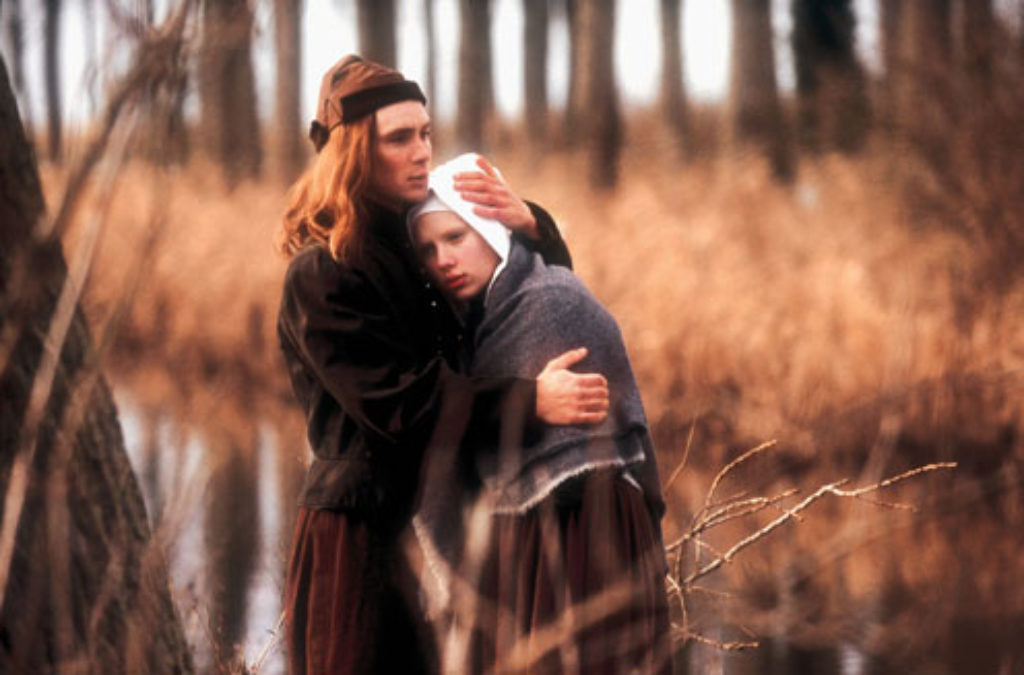
When Tracy Chevalier penned Girl With a Pearl Earring, a novel that eventually sold more than 2 million copies worldwide and became the launching pad for this movie, she was inspired by a poster in her bedroom of Johannes Vermeer’s painting of the same name. Only a few facts are known about Vermeer’s life, so she imagined a back story …
The year is 1665. Dutch master Johannes Vermeer, while greatly talented, struggles to complete his works of art in a timely manner. The consequence of this lack of assiduousness is financial pressure—something that dogs his family constantly. Johannes is married to Catharina, with whom he shares 10 children (and one more on the way). All the Vermeers live at Catharina’s mother’s house, where Johannes maintains his studio.
Although funds are tight, they still manage to sustain an upper-middle class lifestyle complete with two domestic servants. The newest of these is 17-year-old Griet, who has been forced into the job market following a kiln explosion that disabled her father, a tile painter.
It’s in the Vermeer’s home that Griet discovers she shares a passion for color, shape, illusion and light with the Dutch master. What develops, however, soon goes far beyond art. Quickly, Vermeer’s interest in his new maid becomes an obsession. Correspondingly, despite entertaining a deepening relationship with the neighborhood butcher’s son (Pieter), Griet finds herself inexorably drawn into Vermeer’s web. As an employee, she’s unsure how to resist her boss’ advances. As a young woman, she’s not sure she really wants to.
As a teenager, Griet’s sacrifice to become her family’s breadwinner is noble.
Griet’s mother warns her to beware of “Catholic prayers,” adding, “If you have to [hear] them stop your ears!” The newest of the Vermeer clan is baptized using a Trinitarian formula recited in Latin. A painting of Jesus being attended by disciples after the crucifixion is displayed on a wall. Catharina uses the expression, “By all the saints.” At a church, a pastor can be heard (although not seen) saying, “Let’s give thanks …”
Although lust and power are key themes, and sexual tension propels the story, Johannes and Griet do not consummate their relationship. (So this film could have been a lot worse.) Still, at its essence Girl With a Pearl Earring is about a married father of 11 lusting after his teenage maid. With great desire, Vermeer gazes at Griet in several scenes, including one in which he voyeuristically watches her remove her headgear in private (something she refused to do for him earlier as it would have been immodest). Several scenes accentuate Vermeer touching his maid’s hands, first almost incidentally, then more intentionally. After Johannes pierces Griet’s ear, he comforts her with a tender hug, then caresses her lips with his fingertips.
The movie assigns no downside to Vermeer’s affair-of-the-mind other than the fact that he has to listen to his wife spout off about his painting being “obscene” (it isn’t), envious that she wasn’t chosen as the subject of his art. Alas, it is Catharina who is vilified. While she is overbearing and mean-spirited as a rule, her reaction to her husband’s “infidelity” is most certainly justified. But our sympathies are consistently turned toward Johannes, who, after all, has to live with an inconsiderate wife. Griet’s budding relationship with Pieter never seems to satisfy the young maid. Still, the couple does kiss passionately. Later, in a stable, it’s implied that what is viewed onscreen (fervent affection) eventually leads to physical intimacy off screen. Master van Ruijven, the wealthy patron of Vermeer’s art, attempts to rape Griet, but is interrupted before he can go any further than to tear her dress (no nudity is shown). Earlier he refers to a woman’s breasts as “plump little bubbies.” And it is explained that van Ruijven impregnated one of the subjects of a painting he commissioned. Several women, including Catharina, wear low-cut dresses. Johannes caresses his (fully-clothed) wife while she plays the harpsichord.
After Griet spies one of Johannes’ daughters wiping mud across her freshly cleaned laundry, she slaps her across the face. When that same daughter is caught stealing a comb, her grandmother swats her across the hand with a rod. So that Griet can model the pearl earring for Vermeer’s painting, he pierces her ear with an awl, drawing blood. Van Ruijven attempts to rape Griet.
Two abuses of God’s name (both from the villainous van Ruijven) join one use of “p-ss” and a slang term for breasts.
No one is shown intoxicated, but wine is frequently served at meals and social settings. Catharina’s mother smokes.
[Spoiler Warning] The movie ends with Griet being kicked out of the Vermeer home by Catharina. Shortly thereafter, however, Griet receives a package containing the set of pearl earrings that belonged to Catharina. (This suggests that Johannes is still interested.) Some viewers may be grossed out by a butcher’s stand that displays pig heads and other animal parts.
No onscreen sex. No nudity. Very few language problems. And just hints at violence. Despite the relatively small amount of overtly objectionable content, though, Girl With a Pearl Earring is far from acceptable entertainment, celebrating middle-aged lechery, and embracing inappropriate relationships and lustful thoughts.
If Vermeer would have seen the error of his ways before the closing credits, begged forgiveness from his wife and Griet, and pledged future faithfulness, this review might read a bit differently (although I would still question why a film about adult-teen lust needs to be made in the first place). But first-time big screen director Peter Webber doesn’t even attempt to moralize, leaving audiences with a hollow, bleak look inside a 17th century dysfunctional family—with little reason to care and plenty of reasons not to.
